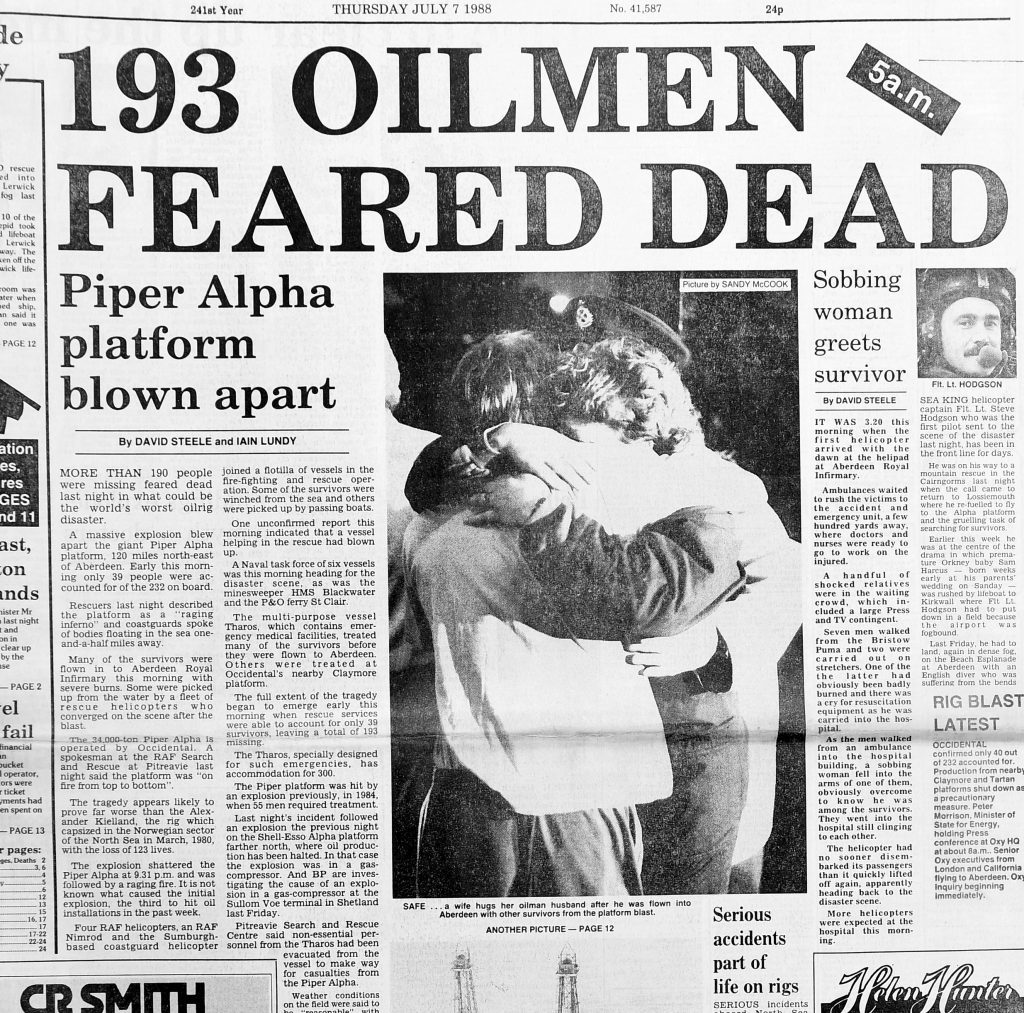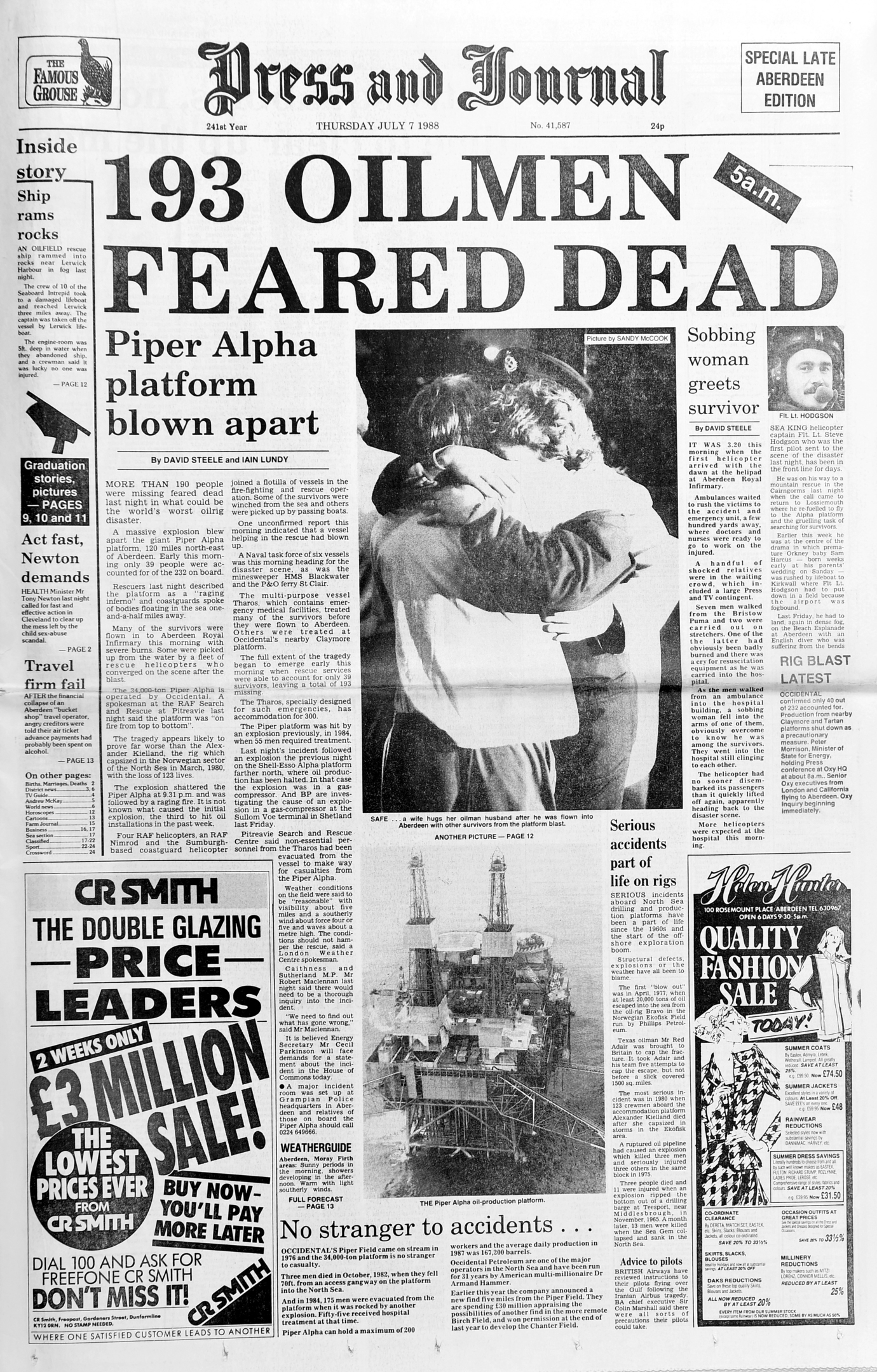
Lest we forget. 28 years on from the worst disaster in the North Sea’s history, Energy Voice looks back on how the Piper Alpha tragedy unfolded and changed the role of safety offshore forever. This excerpt was published on Thursday, July 7, 1988 at 5am.
More than 190 people were missing feared dead last night in what could be the world’s worst oilrig disaster.
A massive explosion blew apart the giant Piper Alpha platform, 120 miles north-east of Aberdeen.
Early this morning only 39 people were accounted for of the 232 on board.
Rescuers last night described the platform as a “raging inferno” and coastguards spoke of bodies floating in the sea one-and-a-half miles away.
Many of the survivors were flown in to Aberdeen Royal Infirmary this morning with severe burns.
Some were picked up from the water by a fleet of rescue helicopters who converged on the scene after the blast.
The 34,000-ton Piper Alpha is operated by Occidental.
A spokesman at the RAF Search and Rescue at Pitreavie last night said the platform was “on fire from top to bottom”.
The tragedy appears likely to prove far worse than the Alexander Kielland, the rig which capsized in the Norwegian sector of the North Sea in March, 1980, with the loss of 123 lives.
The explosion shattered the Piper Alpha at 9.31pm and was followed by a raging fire.
It is not known what caused the initial explosion, the third to hit oil installations in the past week.
Four RAF helicopters, an Raf Nimrod and the Sumburgh-based coastguard helicopter joined a flotilla of vessels in the fire-fighting and rescue operation.
Some of the survivors were winched from the sea and others were picked by passing boats.
One unconfirmed report this morning indicated that a vessel helping the rescue had blown up.
A Naval task force of six vessels was this morning heading for the scene, as was the minesweeper HMS Blackwater and the P&O ferry St Clair.
The multi-puprpose vessel Tharos, which contains emergency medical facilities, treated many of the survivors before they were flown to Aberdeen.
Others were treated at Occidental’s nearby Claymore platform.
The full extent of the tragedy began to emerge early this morning when rescue services were able to account for only 39 survivors, leaving a total of 193 missing.
The Tharos, specially designed for such emergencies, has accommodation for 300.
The Piper platform was hit by explosion previously, in 1984, when 55 men required treatment.
Last night’s incident followed an explosion the previous night on the Shell-Esso Alpha platform farther north, where oil production has been halted.
In that case the explosion was in a gas-compressor. And BP are investigating the cause of an explosion in a gas-compressor at the Sullom Voe terminal in Shetland last Friday.
Pitreavie Search and Rescue Centre said non-essential personnel from the Tharos had been evacuated from the Bessel to make way for casualties from the Piper Alpha.
Weather conditions on the field were said to be “reasonable” with visibility about five miles and a southerly wind about force four or five and waves about a metre high. The conditions should
not hamper the rescue, said a London Weather Centre spokesman.
Caithness and Sutherland MP Mr Robert Maclennan last night said there would need to be a thorough inquiry into the incident.
“We need to find out what has gone wrong,” said Mr MacLennan.
It is believed Energy Secretary Mr Cecil Parkinson will face demands for a statement about the incident in the House of Commons Today.
Recommended for you

